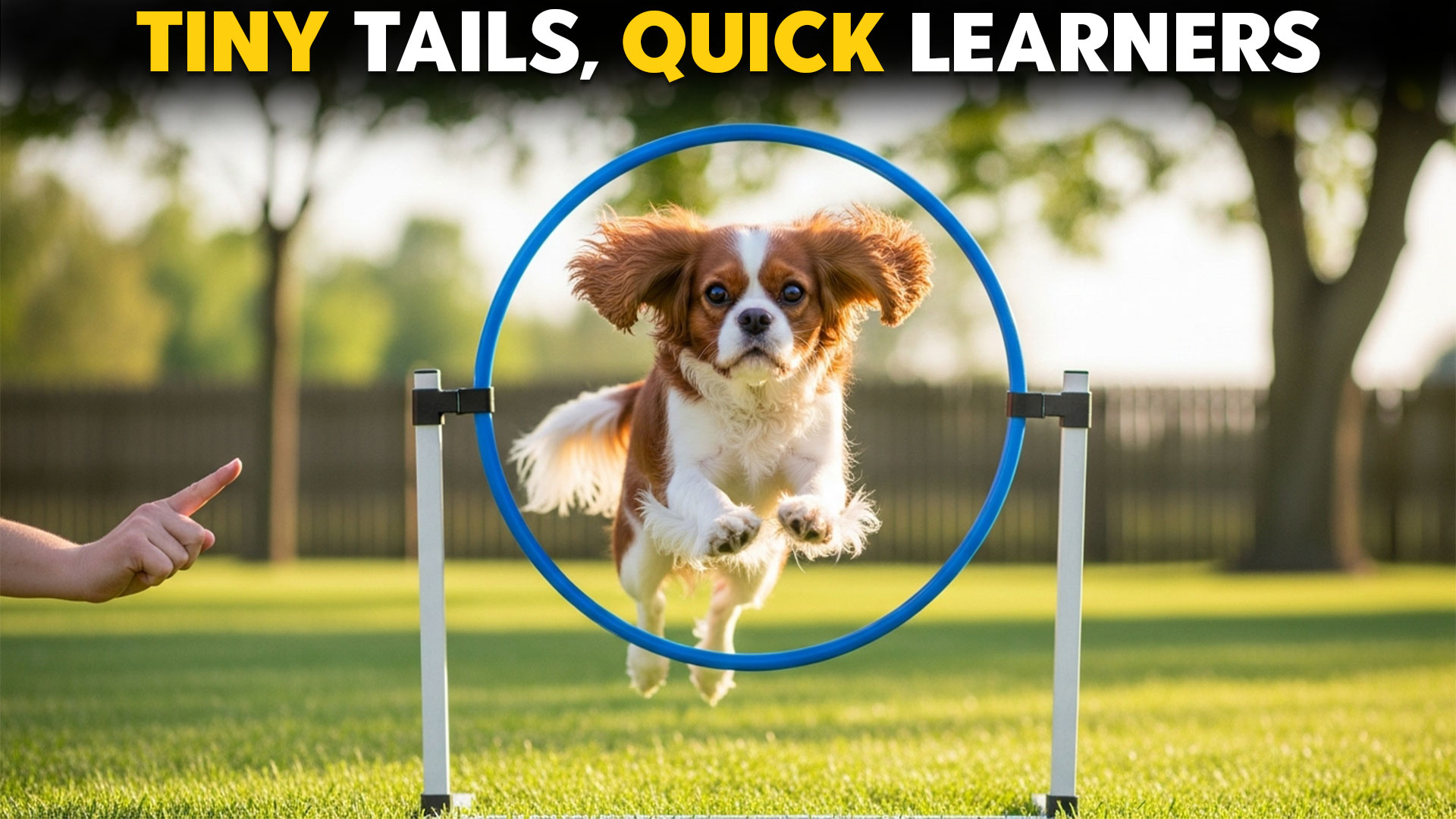Training a dog can feel like a rewarding journey, especially when your pup is eager to learn. While every dog benefits from patience and consistency, some breeds naturally pick up commands faster than others.
Among them, toy breeds stand out for being intelligent, adaptable, and surprisingly quick learners despite their small size. These pint-sized pups prove that you don’t need a big dog to have a smart and responsive companion.
According to research, around 47% of households have a small dog, making them one of the most common companions in American homes. In fact, half of all households own a dog, with most favoring smaller breeds over medium or large dogs.
In this article, we’ll highlight the best toy breeds known for being easy to train. From loyal lap dogs to spirited playmates, you’ll discover which of these tiny but clever canines can bring both companionship and cooperation into your home.
Best Toy Breeds Known For Being Easy Trainable
1. Cavalier King Charles Spaniel
The Cavalier King Charles Spaniel, often simply called the “Cav,” is a toy breed with royal roots, named after King Charles I and his son, Charles II. This small spaniel combines the elegance of a sporting breed with the affectionate nature of a lap dog.
Its large, round eyes and silky coat, available in Blenheim, ruby, black-and-tan, or tricolor, make it instantly recognizable. Britannica notes that a Cavalier’s exercise requirements can be satisfied with a daily walk, whether in a small yard or an apartment setting.
One of the Cav’s strongest traits is its eagerness to please, making training sessions straightforward and rewarding. Their intelligence allows them to grasp commands quickly, often mastering tasks after just a few repetitions. This quality makes them an excellent fit for new owners or families seeking a gentle yet smart companion.
Cavaliers also excel in activities beyond basic obedience. They adapt well to canine sports like agility, rally, and obedience trials, showing both enthusiasm and skill. Their gentle temperament ensures they remain cooperative learners even in busy or distracting environments.
In addition to their trainability, Cavaliers are affectionate and social, thriving in households with children or other pets. Their combination of beauty, intelligence, and charm has made them one of the most beloved toy breeds.
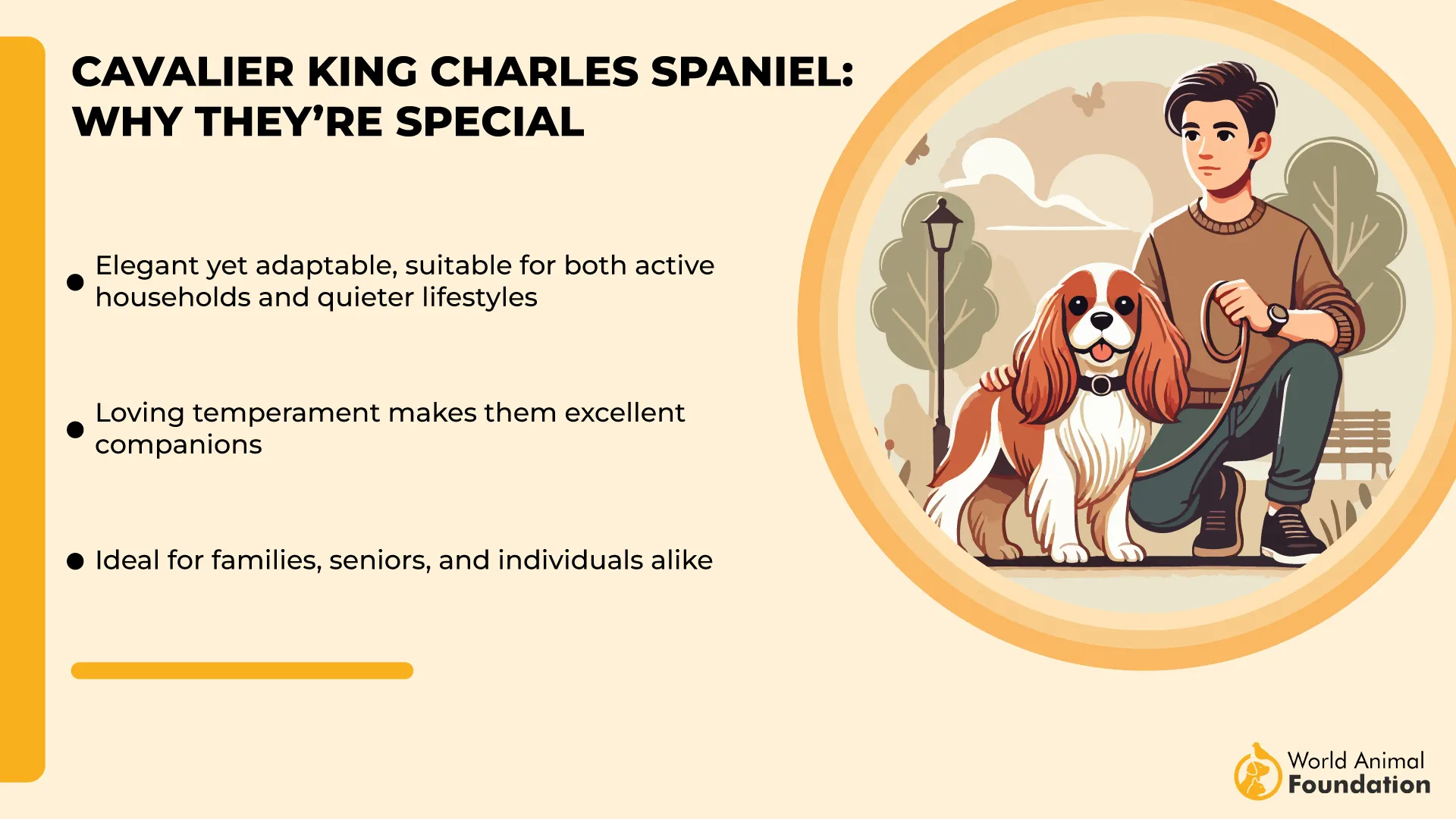
Fun fact: Their sweet, gentle expression is considered a hallmark of the breed.
2. Havanese
The Havanese, also known as the “Velcro dog” for its strong attachment to owners, is the only breed native to Cuba. Recognized by its silky coat, curled tail, and expressive eyes. According to the AKC, these lively and friendly dogs are growing increasingly popular among people living in American cities.
One of the reasons Havanese adapt so well to family life is their intelligence. These pups are quick learners and thrive when trained with positive reinforcement methods. From obedience training to fun games, they eagerly soak up new lessons and can even excel in agility or scent work.
Their cheerful, extroverted personality makes them great with children and other pets, provided they are socialized early. Because they dislike being left alone, they bond quickly with family members and bring comfort to households where companionship is valued.
Adding to their family-friendly appeal, Havanese are naturally affectionate watchdogs. They will alert their owners without being overly barky, and their playful, clownish spirit helps them integrate into nearly any household.
Fun fact: A Havanese puppy from a reputable breeder typically costs between $800–$1,500.
3. Pug
The Pug, also called the “multum in parvo” dog, meaning “a lot in a little,” is one of the most recognizable toy breeds. With their round head, wrinkled brows, and curly tails, these small but sturdy dogs have delighted people for centuries. Originally bred as cherished companions for Chinese emperors, they remain adored worldwide today.
For first-time dog owners, Pugs are excellent because of their affectionate and easygoing nature. They thrive on companionship and are friendly to both people and other animals, which makes them easy to socialize and train. Their playful personality also ensures training sessions are as fun as they are effective.
Another reason they are ideal for beginners is their low-maintenance grooming routine. Their short coats only require occasional brushing, though owners should keep an eye on facial wrinkles to prevent irritation. While they shed, the level of upkeep is manageable for most households, adding to their suitability for novice pet parents.
WebMD notes that exercise needs are modest, making daily walks or playtime in the yard sufficient. However, Pugs do love their naps and are known for snoring due to their flat faces.
Fun fact: Some believe the name “Pug” comes from the Latin word pugnus (“fist”), because their wrinkled faces resemble a clenched fist.
4. Papillon
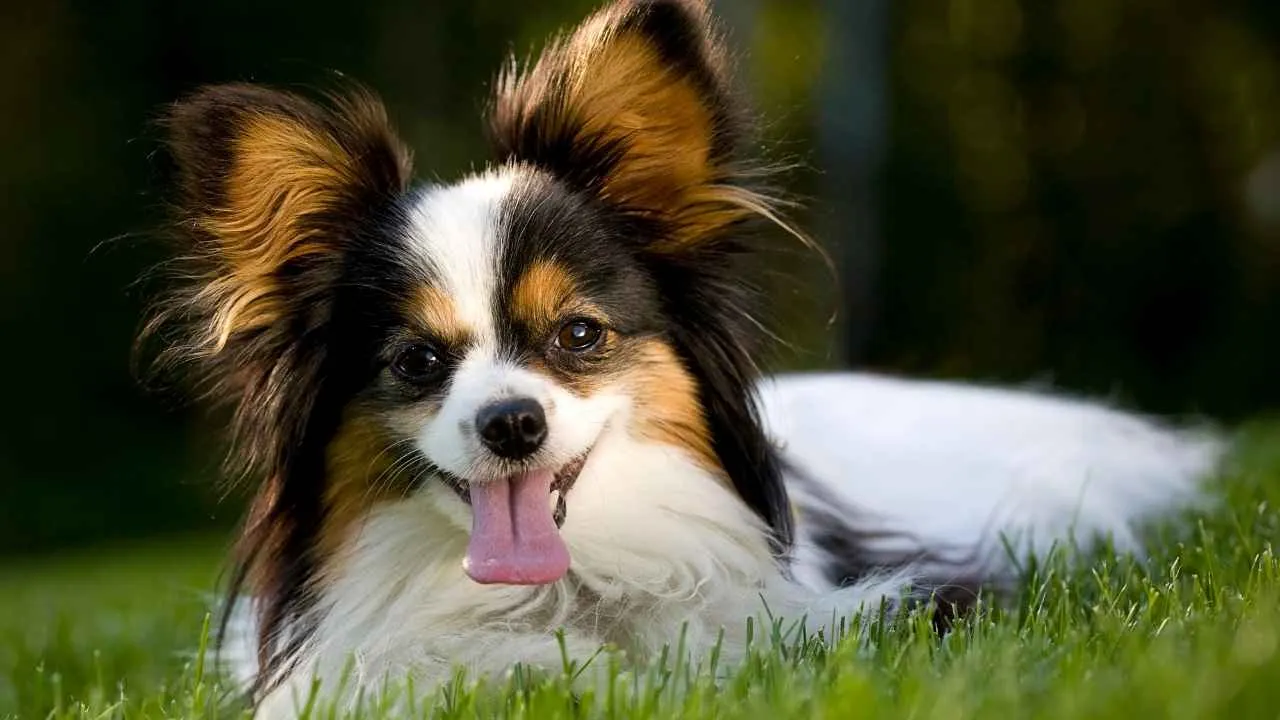
The Papillon, also called the “butterfly dog” thanks to its distinctive wing-shaped ears, is one of the most elegant members of the toy group. This breed is bold, confident, and instantly recognizable for its silky coat and plumed tail.
These cheerful little dogs were originally bred as companions, making them perfect pets for anyone—from individuals in city apartments to families living in the suburbs.
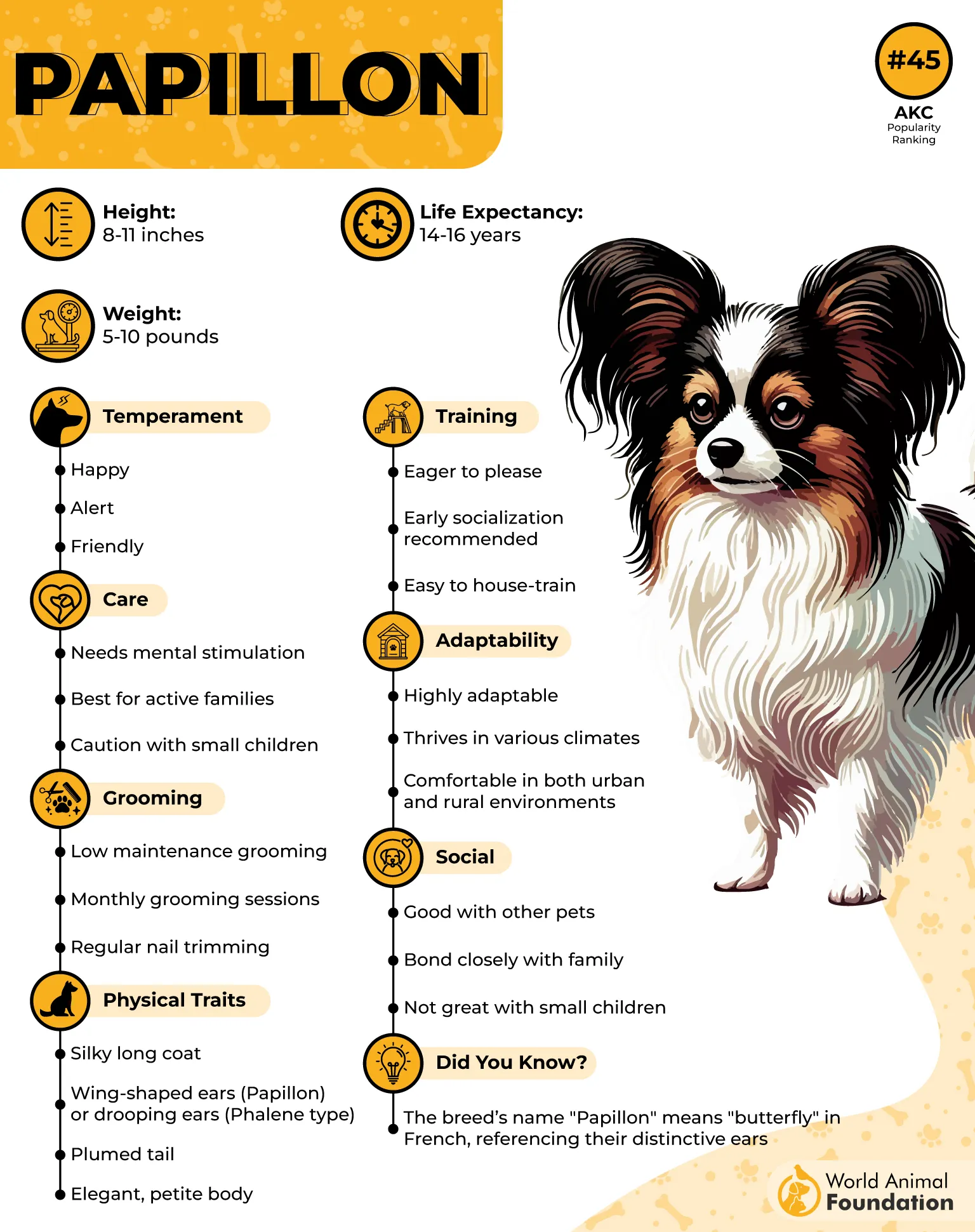
What makes the Papillon stand out as an easy-to-train toy breed is its sharp intelligence and eagerness to please. Known as the smartest of all toy dogs, Papillons are quick learners that thrive on structured guidance and enjoy engaging with their owners. Their curious, upbeat personality means they respond well to mental challenges like puzzles and interactive play.
Positive reinforcement works best with this breed—think treats, praise, and gentle corrections. Papillons flourish in agility, obedience, and rally competitions because of their ability to pick up commands rapidly and retain them. Early socialization is also key to ensuring they grow into well-mannered, confident companions.
While small, these energetic pups need about 30–45 minutes of exercise daily. Balanced training that combines physical activity with mental stimulation—such as agility courses or trick training—keeps them happy and sharp.
Fun fact: Papillons have consistently ranked as top performers in obedience competitions, proving that size doesn’t limit brilliance.
5. Brussels Griffon
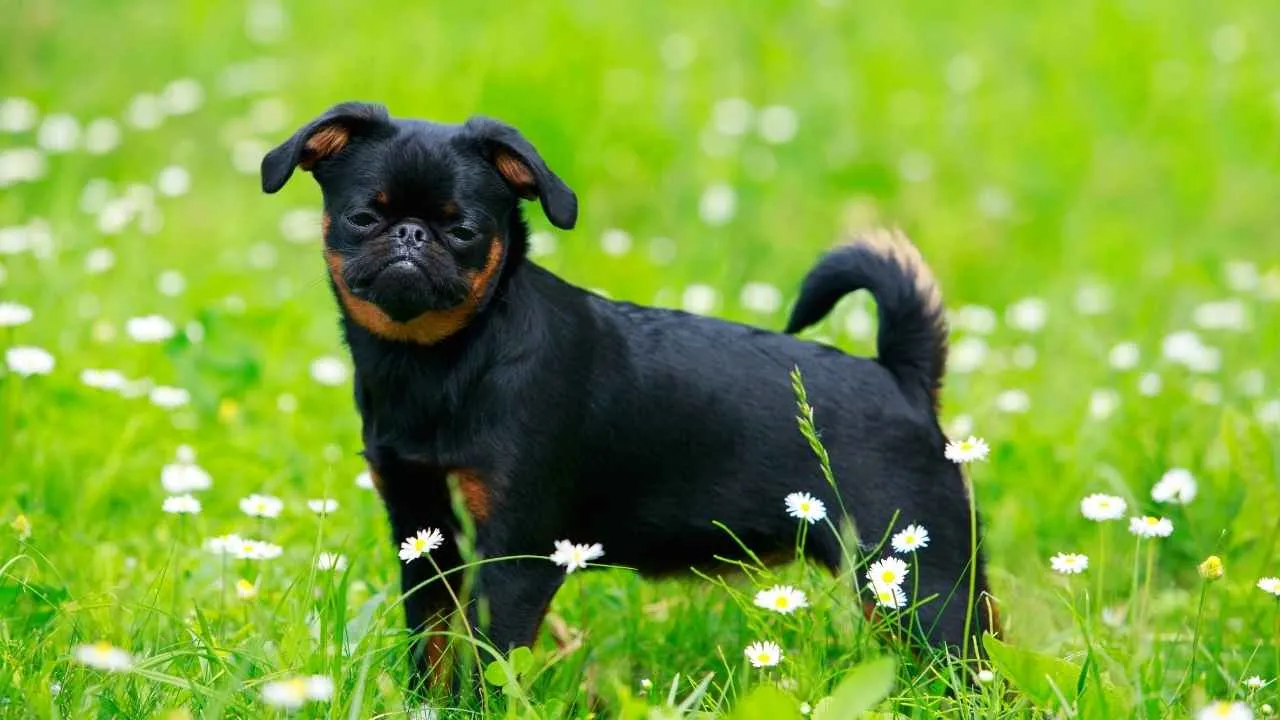
Also known as the Griffon Bruxellois, this toy breed hails from Belgium and is instantly recognizable by its expressive, almost human-like face and soulful eyes. Weighing just 8 to 10 pounds and standing 7 to 10 inches tall, they are sturdy, compact dogs with either smooth or rough coats in colors such as red, black, and belge.
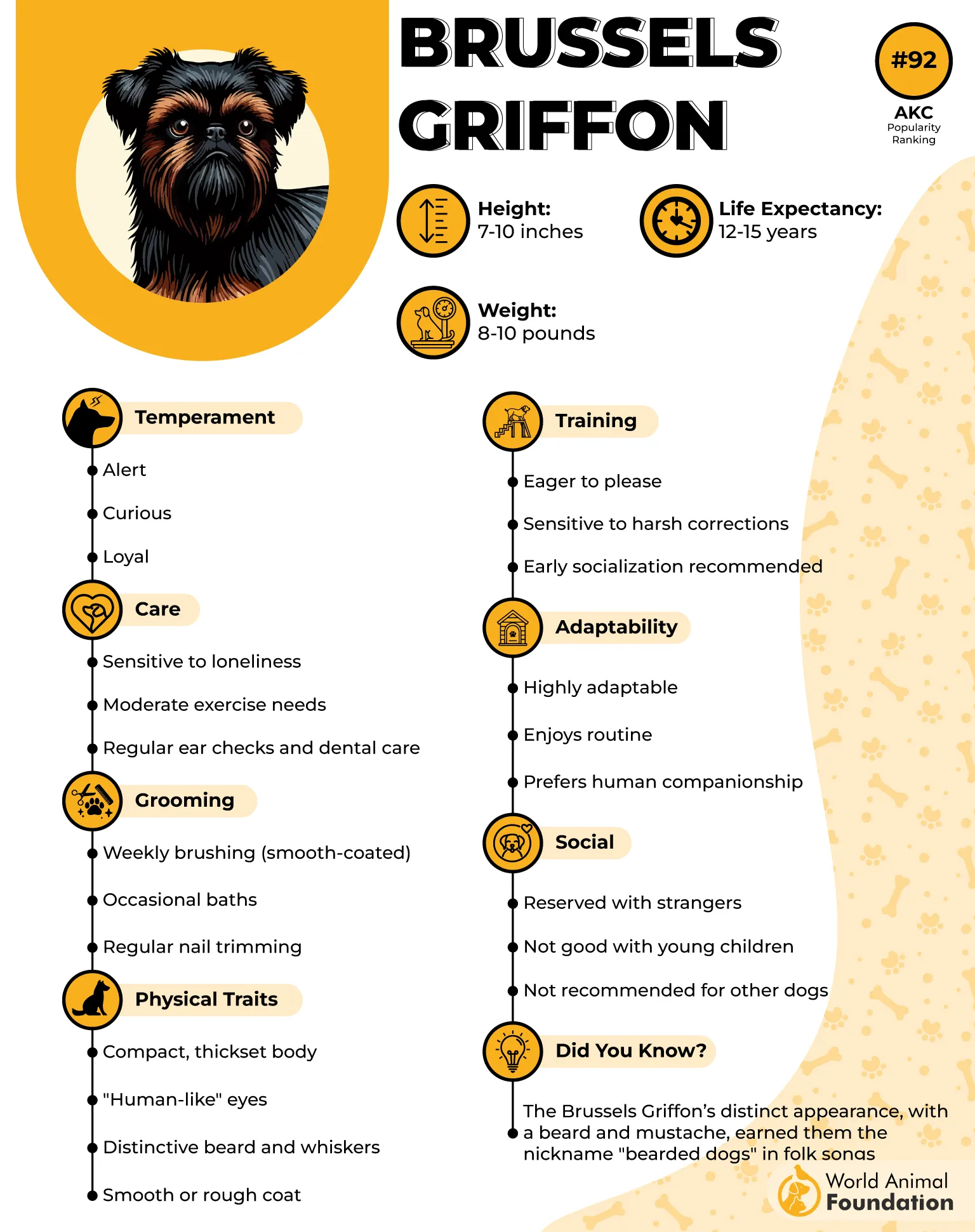
Training a Brussels Griffon works best with positive reinforcement and patience. They are sensitive companions who respond well to encouragement and consistency, but they dislike harsh corrections. Because they thrive on closeness, keeping training sessions short, upbeat, and filled with praise ensures better results.
Their intelligence and loyalty make them eager to learn, though they can sometimes be comically self-important. Socialization from an early age helps them adapt confidently to strangers and other pets. With gentle guidance, they can excel at obedience and even agility exercises.
Despite their toy size, Brussels Griffons have a big personality, often shadowing their favorite person around the house. Known for their alert and curious nature, they not only make excellent lap companions but also are quick learners when training is approached with empathy.
Fun fact: Interestingly, their unique look even inspired the design of Ewoks in Star Wars.
6. Yorkshire Terrier
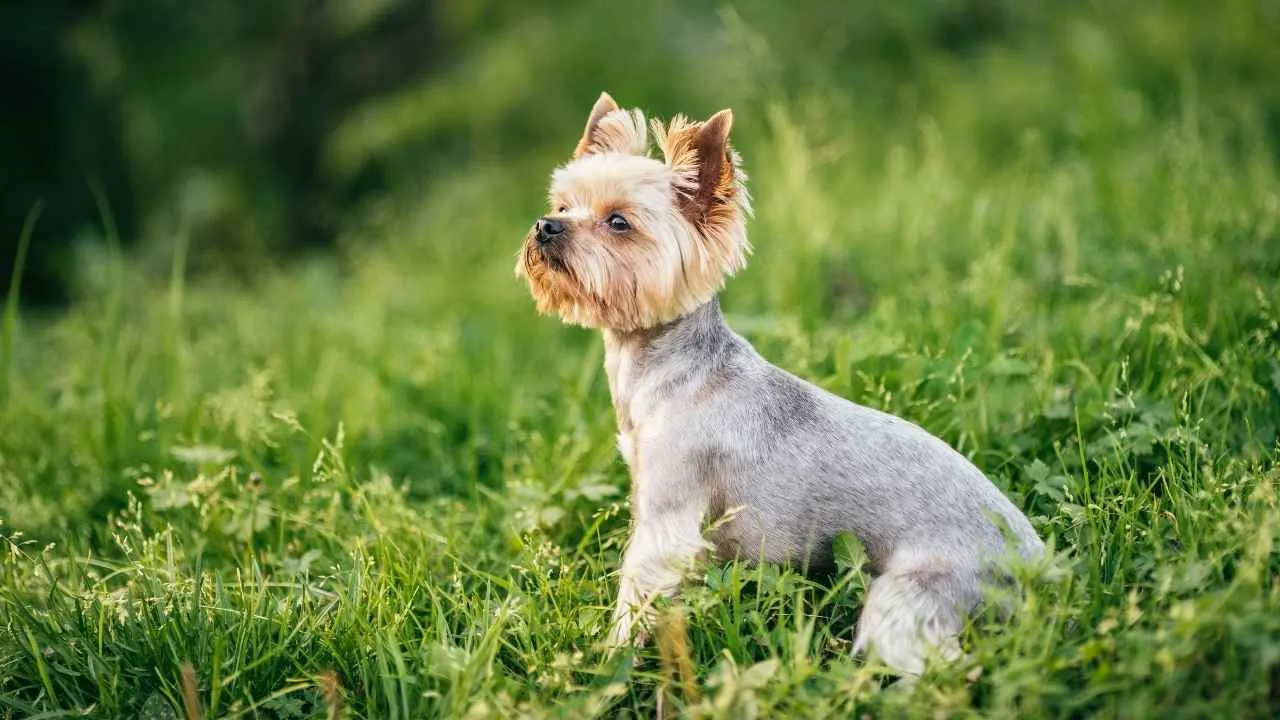
The Yorkshire Terrier, affectionately called the “Yorkie,” is a toy breed recognized for its glossy gray-and-tan silky coat and bold personality. Originally bred as ratters in English mills, these compact dogs usually weigh around 7 pounds and stand about 7–8 inches tall, combining elegance with a terrier’s fearless heart.
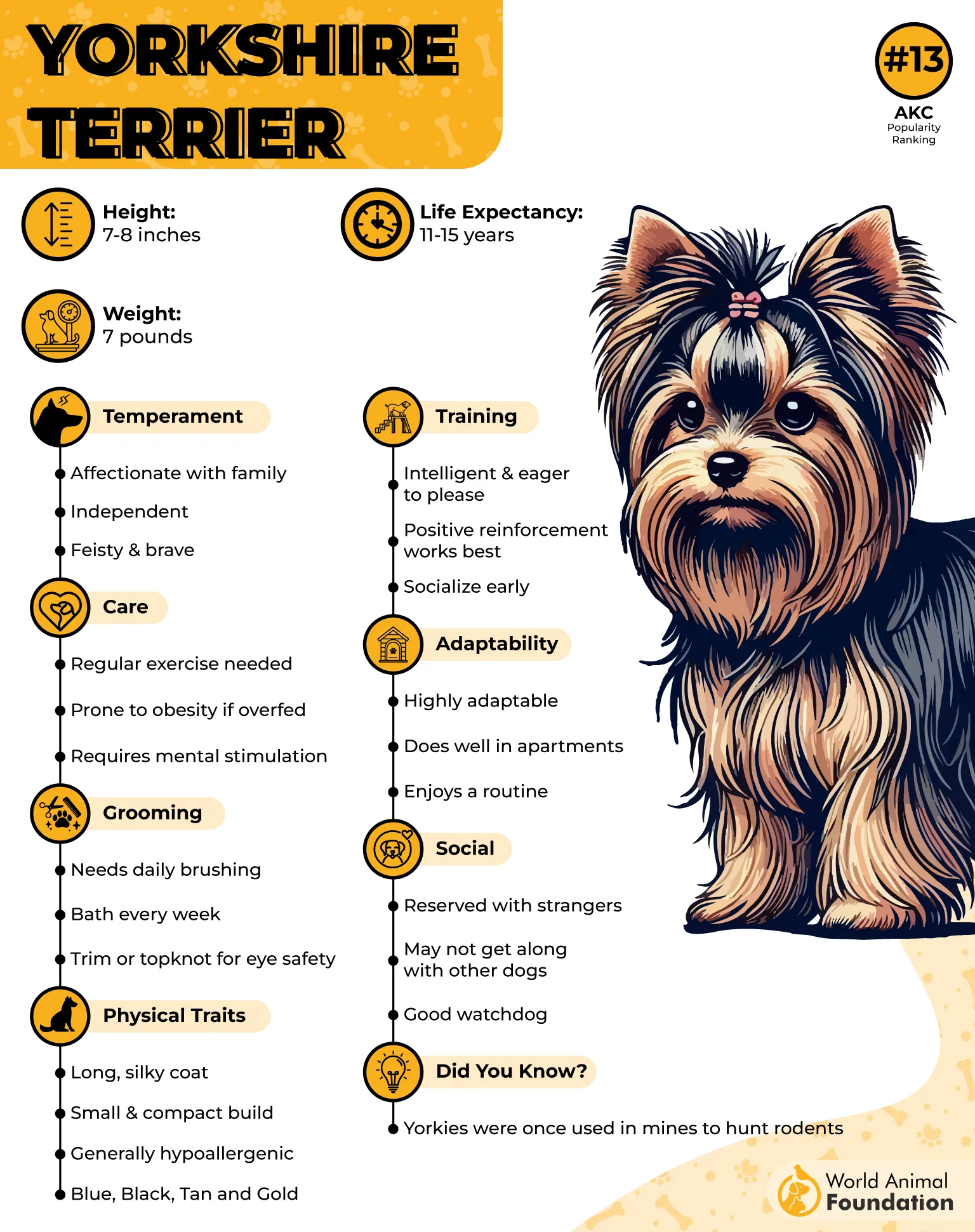
Training a Yorkie requires patience, but it can be very rewarding due to their intelligence and eagerness to bond with their owners. Positive reinforcement methods such as treats, praise, and short, engaging sessions work best to harness their energetic nature. Early socialization is essential, as Yorkies may otherwise become overly protective or stubborn when faced with strangers.
Their lively spirit makes them quick learners, particularly for obedience and simple tricks like sit, stay, and paw. Consistency is key, as these spirited terriers sometimes show a bossy streak. Structured training helps channel their bravery into constructive behaviors, reducing tendencies to bark excessively or lunge at other pets.
Despite their dainty size, Yorkies thrive on activity and mental stimulation. Short walks, puzzle toys, and interactive play sessions keep them sharp and well-behaved.
Fun fact: The very first therapy dog on record was a Yorkshire Terrier named Smoky, who offered comfort to soldiers during World War II.
7. Poodle
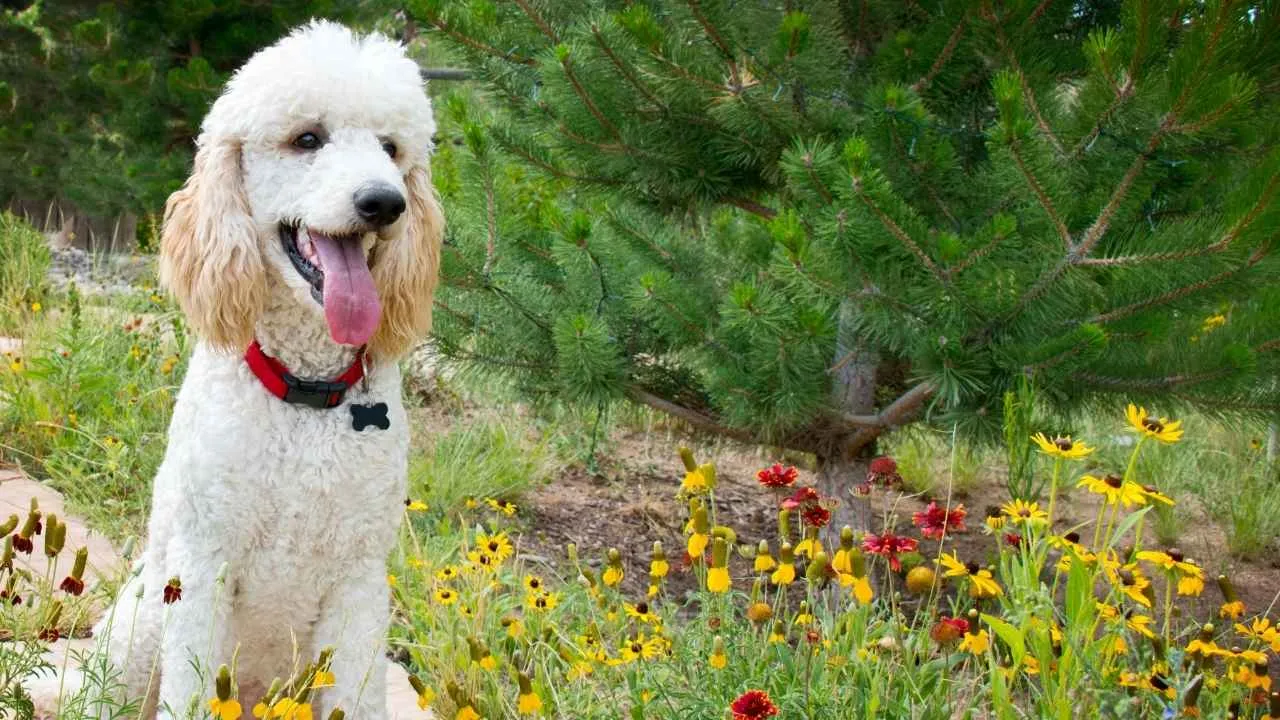
The Poodle, often seen as the “aristocrat of dogdom,” comes in three sizes—Standard, Miniature, and Toy. The Toy and Miniature varieties fit neatly into the toy breed category, adored for their elegance, curly hypoallergenic coats, and highly intelligent nature.
When it comes to training, Toy and Miniature Poodles are eager learners, ranking among the most obedient and responsive small breeds. Their sharp minds thrive on consistent training, making them perfect for owners who want a companion that quickly grasps commands and routines.
These Poodles are also excellent family companions. The Toy variety often prefers a calmer environment, while the Miniature adapts well to households with children. With proper socialization, they get along beautifully with kids and other pets, blending their affectionate nature with playful charm.
Their hypoallergenic, low-shedding coats make them ideal for homes concerned about allergies, though regular grooming is essential. Active and lively, they enjoy walks, games, and even swimming.
Fun fact: The iconic “poodle cut” was originally designed to improve their efficiency as water retrievers.
8. Maltese
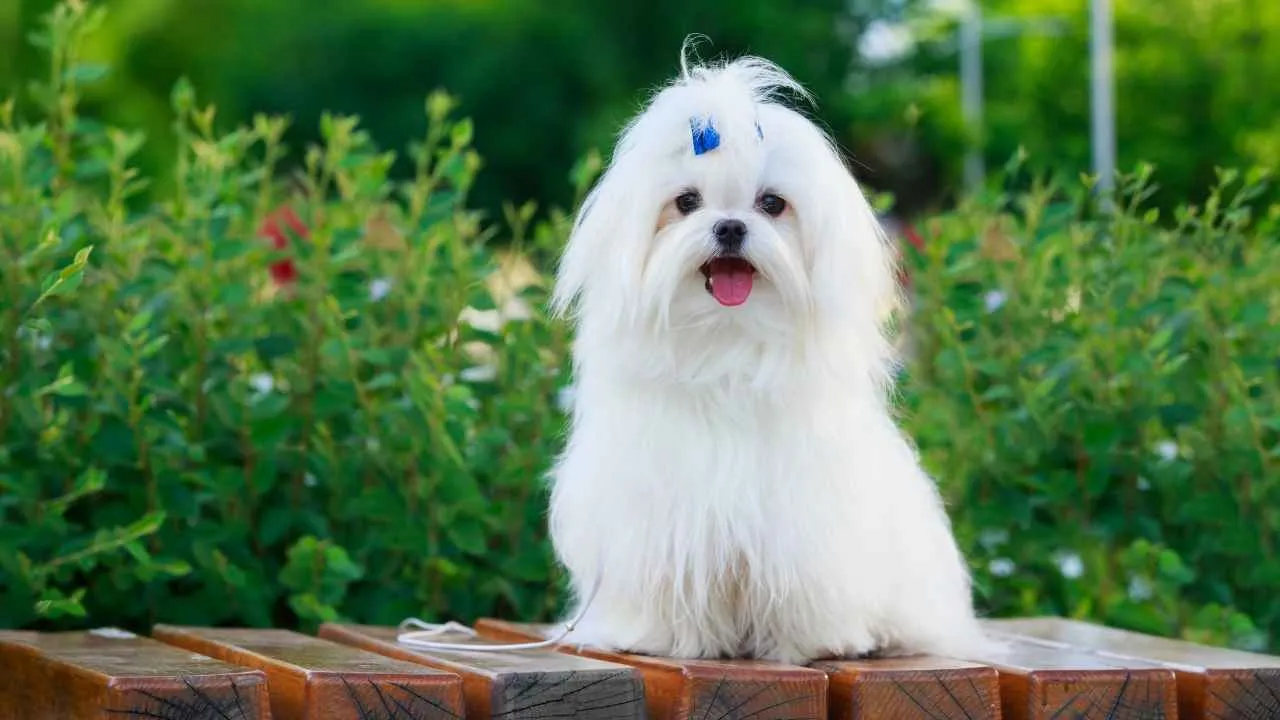
The Maltese, also called the “Ye Ancient Dogge of Malta,” is a distinguished toy breed known for its long, silky white coat and expressive dark eyes. Originating from the Mediterranean region, this breed has been cherished for centuries as a lapdog and companion, often symbolizing status and luxury.
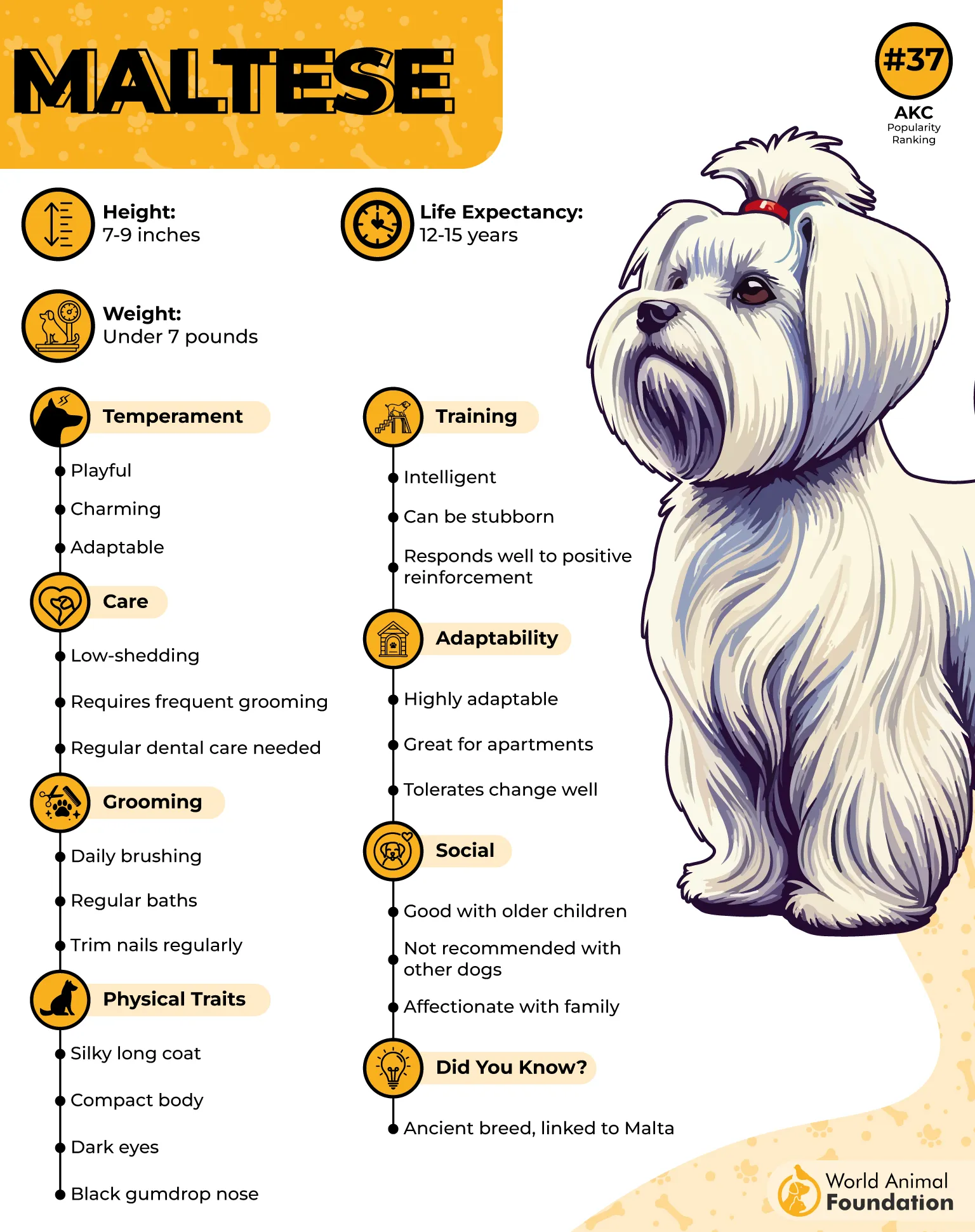
What makes the Maltese especially appealing is their trainability. They are quick learners and enjoy performing tricks, making them a suitable choice for first-time pet owners seeking an easy-to-train toy dog. Consistency and reward-based methods help bring out their best behavior.
Despite their dainty size, Maltese dogs are fearless and playful. They thrive in households with children when supervised, and they typically get along well with other dogs and pets. Their affectionate temperament ensures they bond closely with family members, offering both companionship and cheer.
Because of their low-shedding, hypoallergenic coats, Maltese are an excellent choice for allergy-sensitive homes. They do require regular grooming, but in return, they provide years of loyal companionship.
Fun fact: Roman aristocrats once carried Maltese in their sleeves as symbols of prestige.
9. Pekingese
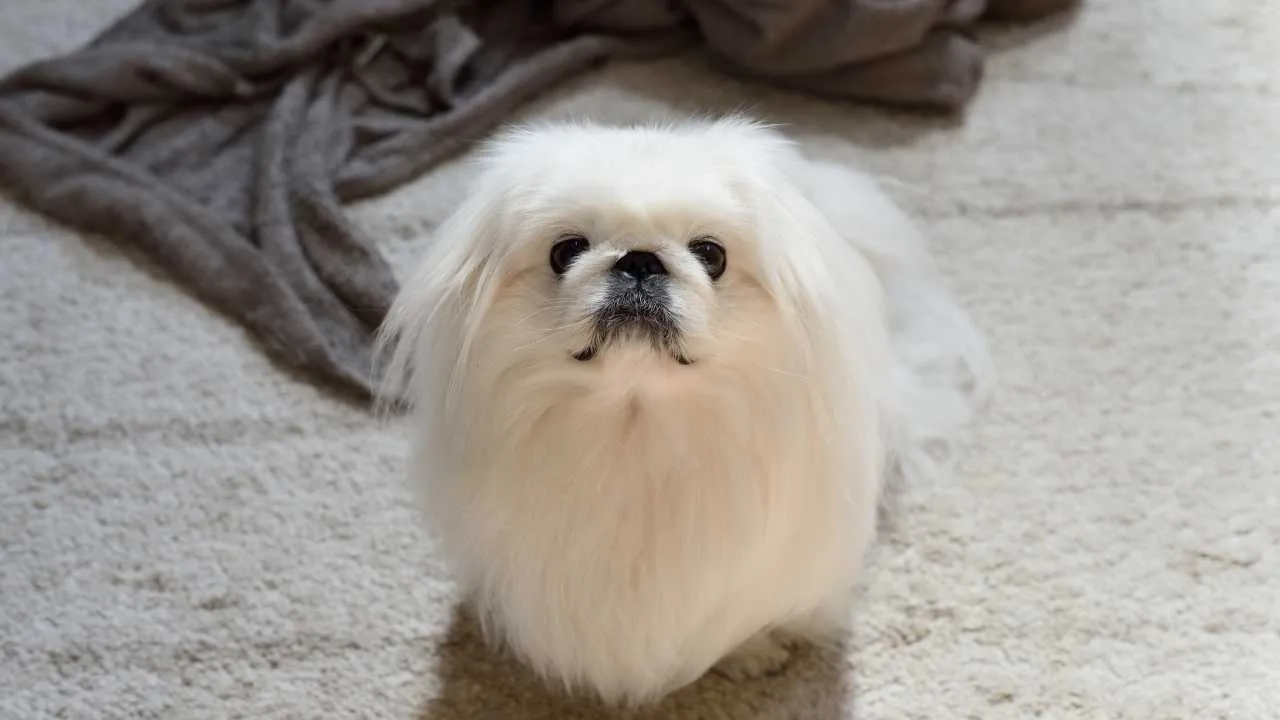
The Pekingese, also called the “Peke,” is a compact toy breed with a long history as a favored companion of Chinese royalty. Known for their lion-like mane, flat face, and distinctive rolling gait, these little dogs carry themselves with regal confidence. Typically weighing between 6 and 14 pounds, they are sturdy yet small enough to adapt well to limited living spaces.
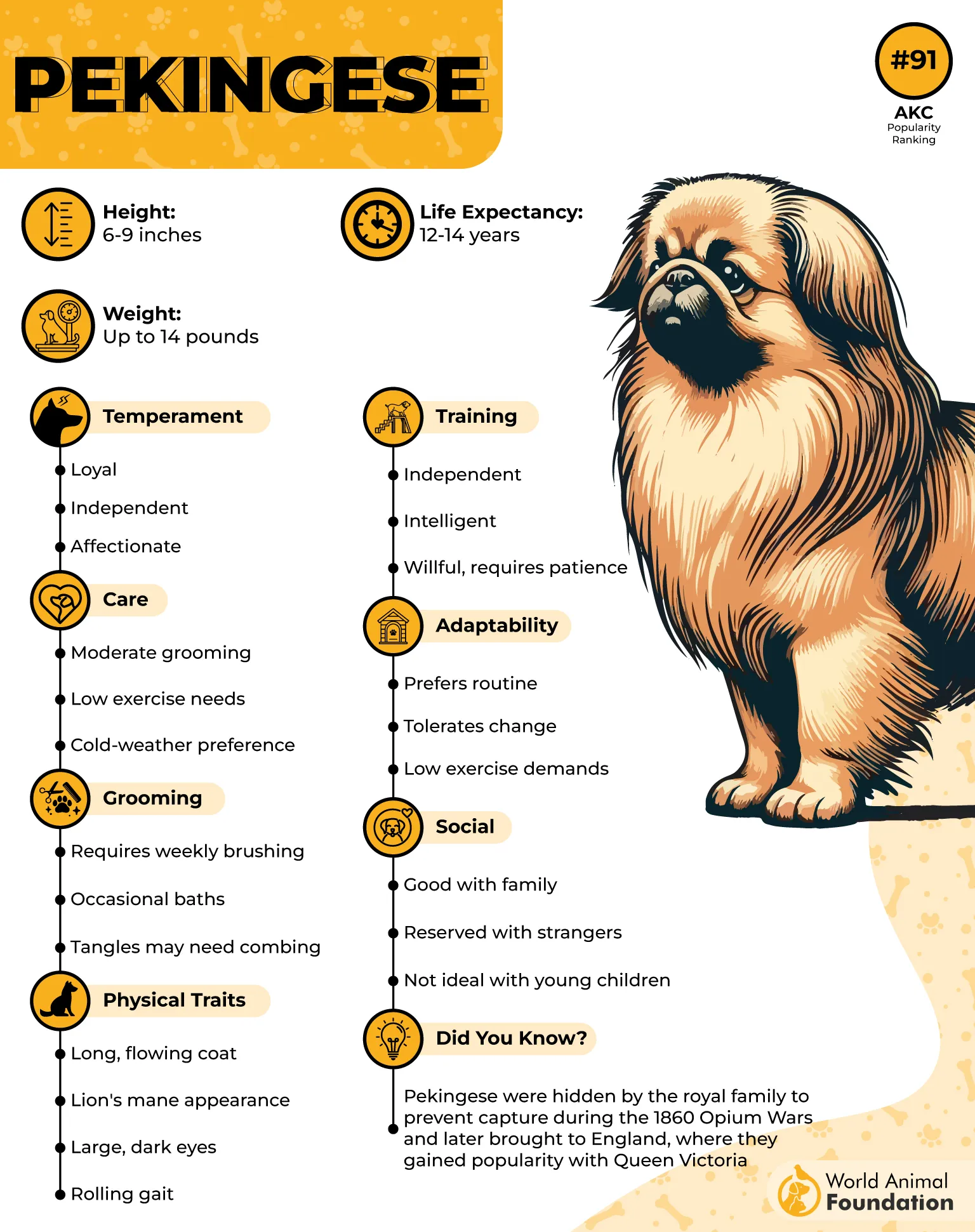
For small home environments, these intelligent small dogs excel because of their moderate activity needs. They are perfectly content with short daily walks and plenty of indoor relaxation, making them ideal companions for apartment dwellers or those without large yards.
While their trainability is rated modest at 5/10, these small dog breeds are intelligent and loyal. Their strong-willed nature requires patience and consistency, but once trained, they thrive as affectionate lap companions who bond closely with their owners.
Their thick double coat adds to their charm but demands regular grooming. Combined with their loyalty and preference for lounging in cozy spaces, Pekes embody the perfect balance of independence and affection.
A fun fact: In ancient China, the smallest Pekingese were called “sleeve dogs” because emperors carried them in their robes.
Conclusion
Selecting the best toy breeds known for being easy trainable ensures a smoother experience for owners looking for both companionship and simplicity. With the right approach to dog training, these small yet eager learners can excel in obedience and agility training, often even participating in dog sports. Other breeds like the Toy Fox Terrier and Shih Tzu are not only adaptable but also make fantastic family dogs, fitting well into homes as affectionate family pets.
Beyond the toy group, highly trainable breeds such as the Miniature Schnauzer, Shetland Sheepdog, and Australian Cattle Dogs also demonstrate remarkable intelligence and responsiveness. Many of these breeds are recognized as excellent therapy dogs, offering emotional comfort alongside their trainability. Whether for first-time owners or experienced handlers, choosing a trainable toy breed brings joy, loyalty, and a rewarding bond that lasts a lifetime.


